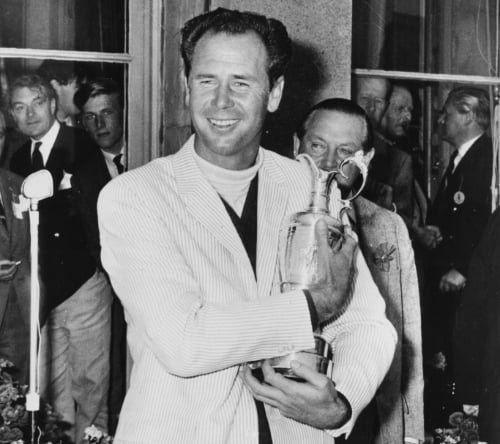
The ancient Chinese philosopher Lao Tzu once said that the flame that burns twice as bright burns half as long.
Oakland native Tony Lema certainly shined bright.
Having lost his father to pneumonia at the age of three, a young Lema, one of four children, turned to golf as an outlet. He’d receive instruction and mentorship from among others Lucious Bateman, Oakland policeman Ralph Hall and Lake Chabot pros Dick Fry and Bill Burch.
In 1951, still just 17, Lema enlisted in the Marine Corps, serving in Korea. Four years later, still just 21, Lema returned to San Francisco where he found work as a golf assistant. Among those that Lema, who was developing into a solid player, garnered attention from was entrepreneur Eddie Lowery.
Lowery, who’d gained fame as the 10-year-old caddie for 1913 U.S. Open champ Francis Ouimet, eventually sponsored Lema, giving him $200 per week to be repaid—Lema keeping two-thirds of his winnings and Lowery getting a third.
Things were starting to happen. In 1957, a win at the Imperial Valley Open helped him earn his PGA Tour card. A year later, Lema had 11 top-15 finishes, earning over $10,000 for the season. But then life struck again. In both 1959 and 1960 combined, he earned less than $10,000. And Lowery came to have his debts repaid.

Lema would again rise to the occasion. In 1962, he got his first PGA Tour win at the Sahara Invitational. A day prior to the victory, Lema joked that he’d serve champagne to the media if he won. For the rest of his career, he’d be known as Champagne Tony.
Over the next four years, Lema kept rising. He’d win two Northern California PGA crowns, 12 official PGA tour events with 11 runner-ups and played on two Ryder Cup squads, going 9-1-1—today still the best record for any player who has competed in two or more.
In 1964, following a win at the Bing Crosby National Pro-Am, Lema rang off three more wins in the next four months. Just a few weeks later, he’d win his first major, capturing the Open Championship on the Old Course at St. Andrews. Lema had only played nine practice holes, winning by five over friend Jack Nicklaus.
Sadly, his last victory would come in May 1966, ironically in his wife Betty’s hometown at the Oklahoma City Open. On the heels of that year’s PGA Championship, Lema and Betty chartered a flight to an exhibition outside Chicago. Their plane would run out of fuel, with the resulting crash killing the Lemas and seven others.
Lema, then just 32, and Betty, 30, would be buried in a cemetery in Hayward following services in Oakland.
In 2018, the NCGA recognized Lema by inducting him into its Hall of Fame.